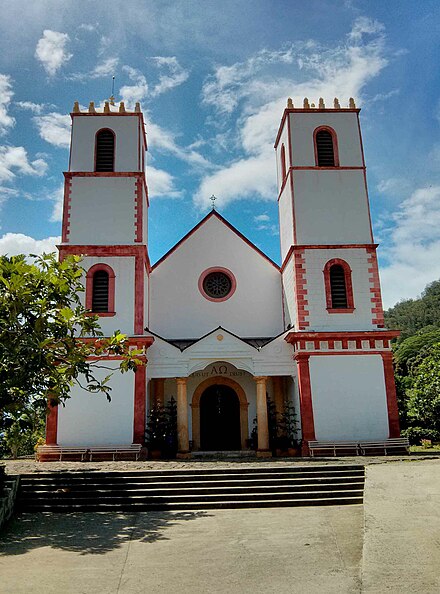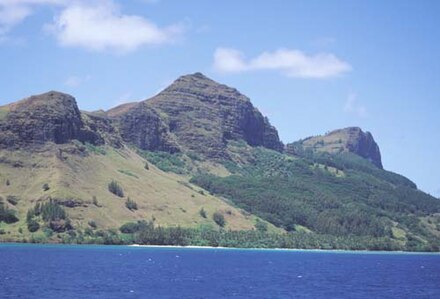Gambier Islands - archipelago in French Polynesia
The Gambier Islands are a group of small volcanic islands surrounded by coral reefs in the southeast extreme of the Tuamotu Islands archipelago of French Polynesia.
Regions
Gambier Group

- Mangareva — the largest island and only island developed for tourism. Mangareva has a permanent population of over 1,200 (2012). The largest village on the island, Rikitea, is the chief town of the Gambier Islands.
- Undeveloped — Akamaru (population 11), Aukena (pop. 30), Taravai (pop. 3), Kamaka (pop. 1).
- Uninhabited — Angakauitai, Apou, Atumata, Gaioio, Kouaku, Makapu, Makaroa, Manui, Mekiro, Motu-O-Ari, Motu Teiku, Papuri, Puaumu, Rumarei, Tarauru Roa, Tauna, Teauaone, Teauotu, Tekava, Tenoko, Tepapuri, Tepu Nui, Teohootepohatu, Tokorua, Totengengie, Tuaeu, Vaiatekeue.
Acteon Group
All the four small atolls in the group are uninhabited: Matureivavao, Tenararo, Tenarunga, and Vahanga.
Understand
There are no ATMs or banks, so you will need to bring enough cash for your stay. Locals here deal with cash only. You can exchange US dollars or euros for French Polynesian francs) at the post office in Rikitea. The pensions sometimes accept credit cards (ask first).
Mangareva is approximately 8 km (5 mi) long and, at 15.4 km² (5.9 sq mi), it comprises about 56% of the land area of the whole Gambier group. Mangareva has a high central ridge which runs the length of the island. The highest point in the Gambiers is Mt. Duff, on Mangareva, rising to 441 m along the island's south coast. The island has a large lagoon 24 km (15 mi) in diameter containing reefs whose fish and shellfish helped ancient islanders survive much more successfully than on nearby islands with no reefs.
Climate
At 23 degrees south, you will find the subtropical climate more comfortable than the main/Society Islands. Humidity is lower, and trade winds provide a welcome relief. The climate is comparable to that of Hawaii.
History
Mangareva was once heavily forested and supported a large population that traded with other islands via canoes. However, excessive logging by the islanders during the 10th to the 15th centuries resulted in deforestation of the island, with disastrous results for its environment and economy.
The first European to arrive at Mangareva was British Captain James Wilson in 1797 on the ship Duff. Wilson named the island group in honour of Admiral James Gambier, who had helped him to equip his vessel.
Mangareva along with its dependencies in the Gambier Islands were ruled by a line of kings and later regents until the French annexed the islands in 1882.
Read
Painter and author Robert Lee Eskridge's book Manga Reva: The Forgotten Islands (Bobbs Merrill; 1931) offers first-hand observations of the environment, peoples, and traditions of Mangareva. Eskridge also wrote and illustrated a children's book about his visit to Mangareva: South Sea Playmates (Bobbs Merrill; 1933).
Talk

Get in
By plane
- Totegegie Airport (IATA: GMR). This domestic airport is on one of Mangareva's island reefs, about 9 km from the main town of Rikitea. From Papeete (IATA: PPT), Air Tahiti Flight Number VT951 leaves at 05:40 and arrives at 11:05 and the flight back on the same day is from 11:55 and arrives at Tahiti at 14:50. Air Tahiti flies weekly from Hao (IATA: HOI) and Tureia (IATA: ZTA). The airport is connected to Mangareva and its city Rikitea by taxi boat. 2020-01-15
Get around
There are no rental cars. Arrange with your pension to be picked up at the dock (after taking the ferry from the airport on the motu). The island's 27-km (16-mile) circle road can be walked in 4-6 hours. It's a great walk. If you wish to see one of the other islands in the group, ask your pension about day trips. Pension Moroi offers a great day trip to see several other islands. It's a fascinating day.
See
- Rikitea Ruins - At Mangareva's main village, Rikitea, visitors will find a number of ruins. Among these archeological relics are a convent, a triumphal arch, several watchtowers, a prison and a court. These abandoned remains have been noted for their dark, eerie feel.
- Rikitea Rectory - Across the path from St. Micheal of Rikitea Church is a well-maintained 140-year-old rectory, occupied by the parish priest.

- St. Michael's Cathedral, Rikitea. Its historic neo-Gothic church was built on the eastern side of Rikitea between 1839 and 1848 by missionaries of the Congregation of the Sacred Hearts of Jesus and Mary. The building measures 48 m by 18 m, and rises to a height of 21 m. It can seat 1200 people, and is thrice the size of Notre Dame Cathedral in Papeete. It is the largest church in the South Pacific. It is constructed of coral limestone and coral lime plaster, imported by raft from quarries at Tauna, Tekava, and Kouaku. The two towers were built in 1847–48. The interior is richly decorated with mother of pearl. The altar has ornamentation of fine pearl oyster engravings of Mother-of-pearls, encased with black pearls. 2020-01-15
Do
 Enjoy a piece of the planet nearly untouched by the modern world. The lagoon is stunning. Tour a black pearl farm. Spend a day on a motu having a picnic, tour Mangareva's historic churches. Snorkeling is quite good, if only there was a dive operation. Watch the stars at night. Hike around the entire island, or to the top of Mt. Duff, , the only volcanic remnant of all the original volcanoes which made up the Tuamotu archipelago.
Enjoy a piece of the planet nearly untouched by the modern world. The lagoon is stunning. Tour a black pearl farm. Spend a day on a motu having a picnic, tour Mangareva's historic churches. Snorkeling is quite good, if only there was a dive operation. Watch the stars at night. Hike around the entire island, or to the top of Mt. Duff, , the only volcanic remnant of all the original volcanoes which made up the Tuamotu archipelago.
Eat
There are one or two restaurants in Rikitea. You can also eat at the pensions (let them know ahead of time as they only prepare enough food for those they know are coming for dinner). Food at the pensions is simple, tasty, and plentiful and you will not go hungry. The hospitality is heartwarming.
Drink
Despite the legacy of French nuclear testing at nearby Muraroa atoll, the water is safe to drink, and bottled water is available from small shops in town. Many of the locals, the soils, and groundwater have been tested for residual radiation by the French government and Greenpeace. All results were negative for radionucleotides. There are no surface streams or wells, and all potable water is collected by catchment from roofs, and thus quite safe to drink.
In Rikitea there are two small markets. One has a decent selection of alcohol, but you will pay dearly for anything but beer. A bottle of Absolut Vodka was priced at nearly USD100. If you wish to have anything specific for you trip you'd better bring it with you to save money, as prices even in Papeete are high.
At night the pensions and small restaurants in Rikitea serve beer (Hirono). Prices are high, but reasonable given the remoteness of the islands.
Stay safe
The locals are friendly and a delight. Wear lots of suncreen, and be careful of stonefish. Bug spray is recommended. Europeans, and to an increasing degree North Americans, are less modest than Polynesians. Dress appropriately — public nudity is discouraged.
Go next
- Mangareva is famous for being the only island that provides a regular travel link to the Pitcairn Islands. Hop on a boat for a 32-hour ride. Mangareva is reached by boat from the nearby airport across the lagoon.
- Tuamotu Islands